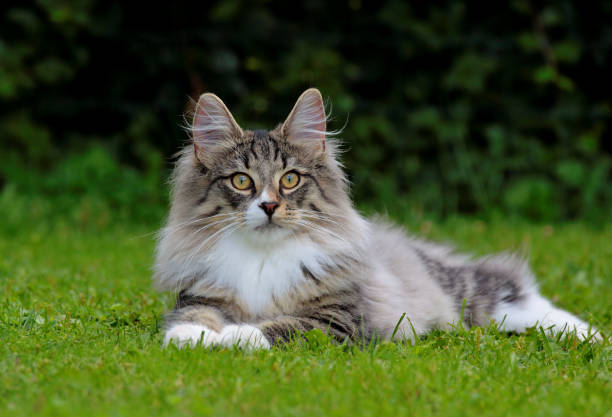Norwegian Forest Cat

History:
The Norwegian Forest Cat, known locally as “Norsk Skogkatt,” is a natural breed that has inhabited Norway for centuries. This hardy, outdoor-loving cat was well adapted to survive the harsh Scandinavian winters with its dense, water-resistant double coat. Its origins trace back to the Viking Age, and it is believed that the breed is descended from cats brought to Norway by Viking explorers. The Norwegian Forest Cat was formally recognised as a breed in the mid-20th century, gaining popularity worldwide for its rugged good looks and friendly nature. It holds a special place in Norwegian folklore and is admired for its independence, agility, and affectionate personality.
Size: Large-sized cat
Height: 25–35 cm
Weight: 4.5–9 kg
Life Expectancy: 12 to 16 years

Breed Appearance:
Norwegian Forest Cats are large, muscular cats with a strong bone structure and a long, rectangular body. They have a broad chest, sturdy legs, and large, tufted paws adapted for walking on snow. Their head is triangular with a straight profile, large almond-shaped eyes, and tall ears that are often tufted at the tips. The breed’s signature feature is its thick, water-repellent double coat consisting of a woolly undercoat and a long, glossy outer coat that forms a ruff around the neck and breeches on the hind legs. Their bushy tail is long and plumed. Coat colours and patterns are diverse, including solid, tabby, tortoiseshell, and more, reflecting the breed’s natural origins.
Health & Care:
Norwegian Forest Cats are generally healthy but can be prone to certain genetic conditions like hypertrophic cardiomyopathy (HCM) and glycogen storage disease type IV, so reputable breeders screen for these. They benefit from regular veterinary visits, dental care, and a balanced diet. Their thick coat requires regular grooming—usually brushing two to three times per week—to prevent matting and reduce shedding. They are active cats that need both mental and physical stimulation to maintain health and happiness.

Living Conditions:
Norwegian Forest Cats adapt well to both indoor and outdoor living, but thrive best with access to safe outdoor areas where they can climb and explore. They are social and affectionate but maintain an independent streak. The breed typically gets along well with children and other pets, making them great family companions. They enjoy climbing structures, scratching posts, and interactive play, which helps satisfy their natural hunting instincts.
Grooming:
Due to their dense double coat, Norwegian Forest Cats require regular grooming to avoid mats and tangles. Brushing two to three times weekly is recommended, with more frequent care during heavy shedding seasons. Nail trimming, ear cleaning, and dental hygiene are essential parts of their routine care. Bathing is rarely necessary but can be done occasionally. Good grooming helps keep their coat healthy, shiny, and free of debris.

Advantages:
-
Norwegian Forest Cats are friendly, adaptable, and affectionate while retaining a strong independent nature.
-
Their thick, weather-resistant coat makes them well-suited for cold climates.
-
They are intelligent and playful, enjoying climbing and interactive toys.
-
The breed gets along well with children and other pets, fitting well in family homes.
-
They have a majestic, natural appearance with a rugged, athletic build.
Disadvantages:
-
Their thick coat requires regular grooming to prevent mats and manage shedding.
-
They may exhibit a strong independent streak, sometimes preferring solitude.
-
Norwegian Forest Cats need space and environmental enrichment to stay active and happy.
-
Potential health risks require careful breeding and monitoring.
-
Their large size and activity level may be challenging for very small living spaces.

